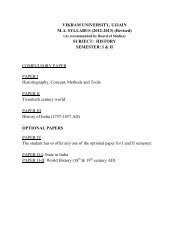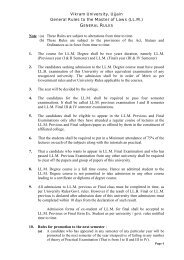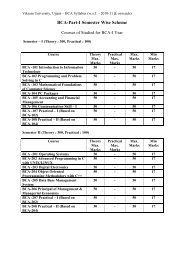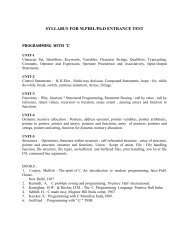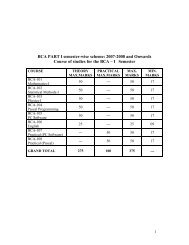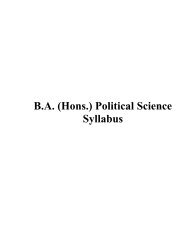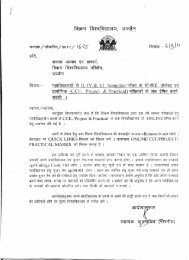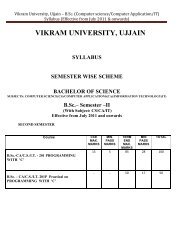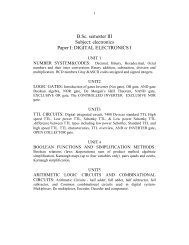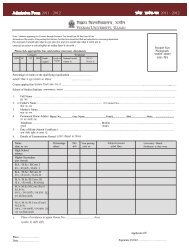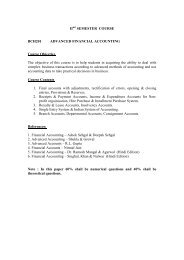Human Rights 1 - Vikram University
Human Rights 1 - Vikram University
Human Rights 1 - Vikram University
Create successful ePaper yourself
Turn your PDF publications into a flip-book with our unique Google optimized e-Paper software.
Post-Graduate Degree Core Paper 1<br />
HISTORICAL AND PHILOSOPHICAL PERSPECTIVES OF<br />
HUMAN RIGHTS AND DUTIES<br />
Objective:<br />
This paper proposes to provide instruction on theoretical, conceptual, historical and<br />
other general aspects of human rights and duties. It encompasses philosophical and<br />
historical foundations, concept of rights and duties, theories of rights and duties, global<br />
and Indian perspectives, concept of the rule of law, co-relationships of rights and duties,<br />
and concept and classification of human duties and responsibilities.<br />
Course Content<br />
1. PHILOSOPHICAL AND HISTORICAL FOUNDATIONS OF HUMAN RIGHTS AND<br />
DUTIES<br />
(i) Philosophical Foundations<br />
(a) <strong>Human</strong> society: man and society<br />
(b) Needs of <strong>Human</strong>kind: material, spiritual<br />
(ii) Historical Development<br />
Magna Carta, British Bill of <strong>Rights</strong>, French and American Declarations,<br />
International Bill of <strong>Rights</strong>.<br />
2. THE CONCEPT OF RIGHTS<br />
(i) Meaning, nature and definition<br />
(ii) Classification of rights<br />
3. THEORIES OF RIGHTS AND DUTIES<br />
(i) Natural rights theory<br />
(ii) Liberal theory of rights<br />
(iii) Legal/positive theory of rights<br />
(iv) Marxist theory of rights<br />
4. GLOBAL AND INDIAN PERSPECTIVES ON HUMAN RIGHTS<br />
(i) Global Perspectives<br />
(ii) 'Third World' Perspectives<br />
(iii) Indian Perspectives on <strong>Human</strong> <strong>Rights</strong><br />
5. RULE OF LAW<br />
6. CO-RELATIONSHIP OF RIGHTS AND DUTIES<br />
(i) Relationship between rights and duties<br />
(ii) Relationship between obligations and responsibilities in relation to the state<br />
and society
7. HUMAN DUTIES AND RESPONSIBILITIES<br />
(i) Concept of <strong>Human</strong> Duties and Responsibilities<br />
(a) Moral, ethical, social, economic, political and cultural<br />
(b) Universal<br />
(c) Traditional/modern<br />
(ii) Classification of <strong>Human</strong> Duties and Responsibilities<br />
(a) Sound Body and Mind<br />
(b) Family<br />
(c) Community and society<br />
(d) Nation-State<br />
(e) <strong>Human</strong>kind and other living beings<br />
(f) Mother Earth
Post-Graduate Degree Core Paper 5<br />
Objective:<br />
HUMAN RIGHTS : THE GLOBAL PERSPECTIVES<br />
The focus of this paper is on the development of international concern for human rights<br />
and of norms and institutional mechanisms at the international and regional levels.<br />
Through nine units, it deals with the emergence of international and regional concern for<br />
human rights; emergence of diverse international instruments on rights and duties; the<br />
role of the United Nations; some specific rights such as self-determination, freedom from<br />
discrimination, freedom from torture, right of women, and rights of the child; European<br />
Convention; American Convention; African Charter and developments in Asian Region.<br />
Course Content<br />
1. HUMAN RIGHTS AND THE UNITED NATIONS<br />
Normative and institutional framework of the United Nations: Role of the UN<br />
General Assembly, the Economic and Social Council and its commissions and<br />
sub-commissions<br />
2. THE INTERNATIONAL BILL OF RIGHTS<br />
(i) Universal Declaration of <strong>Human</strong> <strong>Rights</strong>, 1948<br />
(ii) International Covenant on Economic, Social and Cultural <strong>Rights</strong>, 1966<br />
(iii) International Covenant on Civil and Political <strong>Rights</strong>, 1966<br />
3. SOME SPECIFIC RIGHTS<br />
(i) Right of the peoples and nations to self-determination:<br />
Declaration on the Granting of Independence to Colonial Countries and Peoples
1960, Declaration of Principles of International Law Concerning Friendly<br />
Relations and Cooperation among States 1970 (fifth principle), Declaration on<br />
the Permanent Sovereignty over Natural Resources 1962, Declaration of a New<br />
International Economic Order 1974, Charter of Economic <strong>Rights</strong> and Duties 1974<br />
(ii) Freedom from discrimination<br />
Convention on Elimination of All Forms of Racial Discrimination 1965, onvention<br />
on the Suppression and Punishment of the Crime of Apartheid 1972 and<br />
Convention against Apartheid in Sports 1985, UN Declaration on Elimination of<br />
all Forms of Intolerance and Discrimination based on Religion or Belief 1987,<br />
UNESCO Declaration on Race and Racial Prejudice 1978, UNESCO Declaration<br />
of Principles on Tolerance 1995<br />
(iii) Freedom from Torture<br />
Convention on Prevention and Punishment of the Crime of Genocide<br />
1948,Convention on the Protection of All Persons from Being Subjected to<br />
Torture and Other Cruel, Inhuman or Degrading Treatment or Punishment 1984<br />
(iv) <strong>Rights</strong> of Women<br />
ILO Conventions on Equal Remuneration (1951) and Discrimination in<br />
Employment (1958), Convention on Elimination of All Forms of Discrimination<br />
against Women 1979, Convention for the Suppression of the Traffic in Persons<br />
and of the Exploitation of the Prostitution of Others 1949<br />
(v) <strong>Rights</strong> of the Child UN Convention on the <strong>Rights</strong> of the Child 1989, ILO<br />
Convention on Child Labour 1999<br />
4. EUROPEAN CONVENTION ON HUMAN RIGHTS<br />
5. AMERICAN CONVENTION ON HUMAN RIGHTS 1969<br />
6. AFRICAN CHARTER ON HUMAN AND PEOPLE'S RIGHTS<br />
7. DEVELOPMENTS IN ASIAN REGION
Post-Graduate Degree Core Paper 2<br />
Objective:<br />
SOCIAL DIMENSIONS OF HUMAN RIGHTS IN INDIA<br />
Societal problems of human rights are sought to be dealt with through six units. They<br />
encompass concept and approaches, and a special focus on social, economic, political,<br />
health and cultural problems that underlie human rights deprivations in Indian society.<br />
Course Content<br />
1. CONCEPTS AND APPROACHES<br />
(i) Concept of societal problems and human rights<br />
(ii) Theoretical approaches to social problems and social changes<br />
(iii) Causes and types of social problems
2. SOCIAL PROBLEMS<br />
(i) Problems of hierarchy<br />
(ii) Problems of minorities, scheduled caste and scheduled tribes<br />
(iii) Population explosion<br />
(iv) Violence against women and children<br />
(v) Problems of aged and disabled<br />
3. ECONOMIC PROBLEMS<br />
(i) Poverty and unemployment<br />
(ii) Privatization, liberalization and globalization<br />
(iii) Corruption, consumer rights<br />
(iv) Problems of sustainable development<br />
4. POLITICAL PROBLEMS<br />
(i) Regionalism, terrorism<br />
(ii) Assaults on democracy<br />
5. HEALTH PROBLEMS<br />
Negligence, mismanagement and lack of access to public health care,<br />
environmental degradation<br />
6. CULTURAL PROBLEMS<br />
(i) National and universal cultural conflicts and tensions<br />
(ii) Problems of composite culture<br />
Post-Graduate Degree Core Paper 3<br />
Objective:<br />
HUMAN RIGHTS AND DUTIES IN INDIA :<br />
LAW, POLITICS AND SOCIETY<br />
This paper focuses on the normative and institutional aspects of human rights and<br />
duties against the backdrop of the politics and society in India. Divided into 7 units, it<br />
deals with the Constitution and human rights and duties, special laws for the protection
of vulnerable sections of the people, implementation and enforcement mechanisms,<br />
problems of enforcement, state and society and human rights violations, Indian politics<br />
and human rights violations, and the importance of internalizing human rights and<br />
duties.<br />
Course Content<br />
1. THE CONSTITUTION AND HUMAN RIGHTS AND DUTIES<br />
(i) Constituent Assembly debates on the Fundamental <strong>Rights</strong>, Directive<br />
Principles and Fundamental Duties, Problems of choosing "Fundamental <strong>Rights</strong>".<br />
(ii) Problem of defining reasonable restrictions on fundamental rights<br />
(iii) International human rights and the Indian Constitution<br />
(iv) Fundamental Duties of State and Citizen: problems of implementing Duties<br />
(v) Directive Principles of State Policy<br />
2. SPECIAL LAWS FOR PROTECTION OF SPECIFIC CATEGORIES/ VULNERABLE<br />
SECTIONS OF THE PEOPLE<br />
(i) Reservations and the right to equality<br />
(ii) Protection of Minorities<br />
(iii) Protection of Women: in Private and Public domain<br />
(iv) Contract and unorganized workers; bonded labour<br />
(v) Children<br />
3. IMPLEMENTATION AND ENFORCEMENT MECHANISMS<br />
(i) Judiciary<br />
(ii) National Institutions: SC/ST Commission, Minorities Commission, Women's<br />
Commission<br />
(iii) <strong>Human</strong> <strong>Rights</strong> Commissions: National and State<br />
(iv) Professional Councils : Press, Medical, Bar<br />
(vi) Consumer Courts<br />
(vii) NGOs, Social movements and pressure groups working through democratic<br />
institutions such as lobbying MPs, Information Media<br />
4. PROBLEMS OF ENFORCEMENT OF HUMAN RIGHTS IN INDIA<br />
(i) Poverty and inaccessibility of legal redress<br />
(ii) Abuse of executive power: deaths and torture in police custody etc.<br />
(iii) Special Laws violative of human rights<br />
(iv) Lack of accountability and transparency in government functioning and the<br />
right to information<br />
(v) Inadequate functioning of democratic institutions and democratic deficit<br />
(vi) Social prejudices against caste, women, minorities etc.<br />
5. THE STATE AND CIVIL SOCIETY IN INDIA AND HUMAN RIGHTS VIOLATIONS
(i) <strong>Human</strong> <strong>Rights</strong> violations in private domain : within the family, by dominant<br />
castes, religious groups<br />
(ii) <strong>Human</strong> <strong>Rights</strong> violations in public domain : State, landlords, employers, etc.,<br />
Riots and violence in connection with inter-community tensions<br />
(iii) Unequal access to natural resources<br />
(iv) Impact of development policies on human rights<br />
6. INDIAN POLITICS AND HUMAN RIGHTS VIOLATIONS<br />
(i) Assaults on Indian democracy
Post-Graduate Degree Core Paper 4<br />
RESEARCH METHODOLOGY<br />
1. Meaning and Object of Research Methodology, Use and Role of Research<br />
Methodology in Social Sciences with Special reference to Public Administration.<br />
2. Study of impact of Socio Economic and Political Phenomenon on <strong>Human</strong><br />
Behaviour.<br />
3. Scope and limitation of Social Research.<br />
4. The Scientific Method : Nature, Aim and Basic Elements, Relationship between<br />
Theory and Fact.<br />
5. Theory Building in Public Administration : Concept, Theory and Hypotheses, The<br />
Research Design, Problem Formulation, Population and Sampling.<br />
6. Methods of Collecting Data – Observation, Questionnaire and Schedule,<br />
Interview, The Case Study Method.<br />
7. Data Analysis and Presentation : Coding, Tabulation, Interpretation,<br />
Measurement and Technique of Scaling, Report Writing : Chapters, Footnotes,<br />
References, Rules of Citing and Quotations, Bibliography.<br />
8. Basic Statistics : Frequency Distribution, Mean, Mode and Median, Mean<br />
Deviation, Standard Deviation.
Post-Graduate Degree (Optional I – Paper 6)<br />
<strong>Human</strong> <strong>Rights</strong> of Women and Children In India<br />
1 International Norms for the Protection of Women<br />
i) ILO Conventions for Protection of Female Labour, UN Convention on :Political<br />
<strong>Rights</strong> of Women 1952, Convention on Elimination of All Forms of<br />
Discrimination Against Women, 1979, Declaration on the Elimination of<br />
Violence against Women, 1993.<br />
ii) CEDAW : Composition, Structure and operation<br />
iii) World Conference on Women<br />
2 Status of Women in Contemporary India<br />
i) Poverty, Illiteracy and Violence against Women.<br />
ii) Constitutional and Statutory Provisions<br />
3 Institutional Mechanisms For Protection of Women<br />
i) Constitutional mechanism ; Legislature, Executive and Judiciary (special<br />
contribution of judiciary)<br />
ii) Statutory mechanism : National Commission for Women, National <strong>Human</strong><br />
<strong>Rights</strong> Commission, State Commissions.<br />
iii) The Non-Governmental Organizations.<br />
iv) The information media<br />
v) Role of education<br />
4 International Norms for Protection of the Child.<br />
i) UN Convention on the <strong>Rights</strong> of the Child, 1990<br />
ii) Committee on the <strong>Rights</strong> of the Child : Structure and Operation<br />
iv) UNICEF : Problems and Perspectives.<br />
5 Status of the Child in Contemporary India<br />
i) Poverty, Illiteracy and Child Abuse<br />
ii) Constitutional and Statutory Provisions<br />
6 Institutional Mechanism for Protection of Child<br />
i) Constitutional mechanism ; Legislature, Executive, Judiciary (special<br />
contribution of judiciary)<br />
ii) National Women <strong>Rights</strong> Commission, National Commission for <strong>Rights</strong> of the<br />
Child<br />
iii) Non-Governmental Organizations.<br />
iv) The information media
v) Role of education<br />
Post-Graduate Degree (Optional II– Paper 7)<br />
Objective:<br />
HUMAN RIGHTS AND CRIMINAL JUSTICE SYSTEM<br />
Criminal justice system is one of the critical areas of human rights and duties where the<br />
legal system is tested on a continuous basis for preservation of peace and security in<br />
society on the one hand, and preservation of human dignity of both victims of crime and<br />
persons accused of it. This paper is in ten units which cover, besides the conceptual<br />
and other perspectives, the principal rights problems, rights of the accused, the rights of<br />
inmates of prisons and custodial homes, access to justice, right to compensation,<br />
punishments, administration of justice and international perspectives.<br />
Course Content<br />
1. HISTORICAL, PHILOSOPHICAL AND SOCIAL PERSPECTIVES<br />
<strong>Human</strong> Right Act 1993<br />
2. CONCEPTUAL PERSPECTIVE<br />
(i) Concept of crime and criminal liability<br />
(ii) Offences involving <strong>Human</strong> <strong>Rights</strong><br />
(iii) Role of Criminal Justice System<br />
3. HUMAN RIGHTS PROBLEMS<br />
(i) Police Atrocities and Accountability<br />
(ii) Violence against women and children<br />
(iii) Communal violence<br />
(iv) Caste and class conflicts<br />
(v) Maintenance of Law and Order<br />
(vi) Terrorism and Insurgency<br />
4. RIGHTS OF ACCUSED<br />
(i) Double Jeopardy<br />
(ii) Against self-incrimination<br />
(iii) Production before Magistrate<br />
(iv) Fair Trial<br />
(v) Speedy Trial<br />
(vi) Appeal
5. RIGHTS OF INMATES OF PRISONS AND CUSTODIAL HOMES<br />
(i) Protection Homes<br />
(ii) Reformative and other institutions<br />
(iii) Prisons<br />
6. RIGHT TO LEGAL AID, ACCESS TO JUSTICE AND SPEEDY JUSTICE<br />
7. RIGHT TO COMPENSATION<br />
8. PUNISHMENTS AND HUMAN RIGHTS<br />
9. ADMINISTRATION OF CRIMINAL JUSTICE<br />
(i) Ordinary Courts<br />
(ii) Special Courts<br />
(iii) District <strong>Human</strong> <strong>Rights</strong> Courts<br />
(iv) Nyaya Panchyats<br />
(v) <strong>Human</strong> <strong>Rights</strong> Sensitization<br />
(vi) Threats to the System:<br />
(a) Terrorism<br />
(b) Abduction<br />
(c) Others<br />
10. INTERNATIONAL PERSPECTIVES<br />
(i) International crimes<br />
(ii) International crime control and protection agencies, e.g. Interpol<br />
(iii) International co-operation in combating of transnational organized crimes and<br />
international terrorism - Palermo Convention on Transnational Organized<br />
Crime 2000,Convention against Illicit Trafficking of Narcotic and Psychotropic<br />
Substances 1988-90<br />
(iv) Extradition and mutual assistance in criminal proceedings<br />
(v) International Criminal Court - Rome Statute 1998<br />
(vi) International norms on administration of criminal justice - UN General<br />
Assembly resolutions
Post-Graduate Degree Paper 8<br />
PROJECT WORK<br />
Every Student of Final Year shall be compulsorily doing the Project<br />
Work related to any aspects of <strong>Human</strong> <strong>Rights</strong> and Duties.
<strong>Human</strong> <strong>Rights</strong> and Duties<br />
M.A. Previous and Final<br />
Previous 2007-08<br />
Final 2008-09<br />
There shall be a total number of eight papers for its two years M.A.<br />
Programme in <strong>Human</strong> <strong>Rights</strong> and Duties. Four Paper shall be taken<br />
in M.A. Previous and in M.A. Final three papers and one Project<br />
Work.<br />
1. Historical and Philosophical Perspectives of <strong>Human</strong> <strong>Rights</strong><br />
and Duties.<br />
2. Social Dimensions of <strong>Human</strong> <strong>Rights</strong> in India.<br />
3. <strong>Human</strong> <strong>Rights</strong> in India : Law, Politics and Society.<br />
4. Research Methodology<br />
5. <strong>Human</strong> <strong>Rights</strong> : The Global Perspective
6. <strong>Human</strong> <strong>Rights</strong> and Women and Children in India.<br />
7. <strong>Human</strong> <strong>Rights</strong> and Criminal Justice System<br />
8. Project Work<br />
- Each Paper carries 100 marks and duration of<br />
examination is three hours.<br />
- Every students shall be doing a project work in M.A. Final<br />
on any aspects of <strong>Human</strong> <strong>Rights</strong> decided by the Head of<br />
the Department.<br />
- Project Work evaluation shall be from 50 marks and 50<br />
marks for viva-voce.<br />
POST-GRADUATE DEGREE COURSE (MA/LLM)<br />
IN HUMAN RIGHTS AND DUTIES<br />
This course has 5 core papers and 14 optional papers. They are:<br />
Core Papers<br />
1. Historical and Philosophical Perspectives of <strong>Human</strong> <strong>Rights</strong> and Duties<br />
2. <strong>Human</strong> <strong>Rights</strong> and Duties in International and Regional Perspectives<br />
3. Societal Issues of <strong>Human</strong> <strong>Rights</strong> and Duties in India<br />
4. <strong>Human</strong> <strong>Rights</strong> and Duties in India: Law, Politics and Society, and Importance of<br />
Internalizing Women <strong>Rights</strong> and Duties.
5. Research Methodology and Dissertation/Field-Based Project Work<br />
Optional Papers<br />
1. Science & Technology and <strong>Human</strong> <strong>Rights</strong> and Duties<br />
2. International Obligation to protect <strong>Human</strong> <strong>Rights</strong> and Duties<br />
3. Development, Trade and <strong>Human</strong> <strong>Rights</strong><br />
4. International <strong>Human</strong>itarian and Refugee Laws<br />
5. Peoples' Right to Self Determination<br />
6. Women and <strong>Human</strong> <strong>Rights</strong> and Duties<br />
7. Children and <strong>Human</strong> <strong>Rights</strong> and Duties<br />
8. The Aged and Disabled and <strong>Human</strong> <strong>Rights</strong> and Duties<br />
9. Socially/Economically Disadvantaged People and <strong>Human</strong> <strong>Rights</strong> and Duties<br />
10. Working Class and <strong>Human</strong> <strong>Rights</strong> and Duties<br />
ekuo vf/kdkj ,oa drZO;<br />
,e0,0 iwokZ)Z ,oa mRrjk)Z<br />
iwokZ)Z 2007&08<br />
mRrjk)Z 2008&09<br />
ekuo vf/kdkjksa ,oa drZO;ksa ds f}o"khZ; LukrdksRrj ¼,e0,0½ ikB~;dze esa dqy 8<br />
iz'ui= gksaxs A ,e0,0 iwokZ)Z es a 4 iz'ui= gksaxs ,oa ,e0,0 mRrjk)Z es a rhu iz'ui=<br />
,oa 01 ifj;kstuk dk;Z gksxk A<br />
1 ekuo vf/kdkjksa ,oa drZO;ksa ds ,sfrgkfld ,oa nk'kZfud ifjizs{; A
a<br />
a<br />
2 Hkkjr esa ekuo vf/kdkjks ds lkekftd vk;ke A<br />
3 Hkkjr esa ekuo vf/kdkj % dkuwu] jktuhfr vkSj lekt A<br />
4 'kks/k izfof/k A<br />
5 ekuo vf/kdkj % oSf'od ifjizs{; A<br />
6 Hkkjr esa efgykvksa ,oa cPpks ds ekuo vf/kdkj A<br />
7 ekuo vf/kdkj vkSj vkijkf/kd U;k; iz.kkyh A<br />
8 ifj;kstuk dk;Z<br />
& izR;sd iz'ui= ds vf/kdre vad 100 gksaxs rFkk ijh{kk dh vof/k 3 kaVs<br />
jgsxhA<br />
& ,e0,0 mRrjk)Z esa izR;sd fo|kFkhZ dks foHkkxk/;{k }kjk fu/kkZfjr<br />
ekuokf/kdkj ds fdlh ,d i{k ij viuk ifj;kstuk dk;Z lEiUu djuk gksxk A<br />
& ifj;kstuk dk;Z ds ewY;kadu gsrq 50 vad rFkk ekSf[kdh gsrq 50 vad fu/kkZfjr<br />
jgs axs A<br />
LukRdksRrj fMxzh dksj ¼Hkkx½<br />
iz'ui= & 1<br />
" ekuo vf/kdkjksa vkSj drZO;ksa ds ,sfrgkfld ,oa nk'kZfud ifjizs<br />
{;"<br />
1 ekuo vf/kdkjksa ,oa drZO;ksa dk nk'kZfud ,oa ,sfrgkfld vk/kkj<br />
(i) nk'kZfud vk/kkj &<br />
¼v½ ekuo lekt % ekuo vkSj lekt
¼c½ ekuoh; vko';drk,a % HkkSfrd] vk/;kfRed A<br />
(ii) ,sfrgkfld fodkl &<br />
esXukdkVkZ] fczfV'k vf/kdkj i=] Qzkafllh ,oa vesfjdh<br />
kks"k.kk,a] varjkZ"Vªh; vf/kdkj i= A<br />
2 vf/kdkjksa dh vo/kkj.kk<br />
(i) vFkZ] izd`fr vkSj ifjHkk"kk<br />
(ii) vf/kdkjksa dk oxhZdj.k<br />
3 vf/kdkjksa ds fl)kUr<br />
(i) izkd`frd vf/kdkj fl)kUr<br />
(ii) vf/kdkjksa dk mnkjoknh fl)kUr<br />
(iii) vf/kdkjksa dk oS/kkfud@izR;{koknh fl)kUr<br />
(iv) vf/kdkjksa dk ekDlZoknh fl)kUr<br />
4 ekuo vf/kdkjksa dk oSf'od ,oa Hkkjrh; ifjizs{;<br />
(i) oSf'od ifjizs{;<br />
(ii) *r`rh; fo'o* ifjizs{;<br />
(iii) ekuo vf/kdkjksa ij Hkkjrh; ifjizs{;<br />
5 fof/k dk 'kklu<br />
6 vf/kdkjksa ,oa drZO;ks a dk lglaca/k<br />
(i) vf/kdkjksa ,oa drZO;ks a ds e/; laca/k<br />
(ii) jkT; vkSj lekt ds laca/k esa drZO;ksa ck/;rkvksa ,oa<br />
mRrjnkf;Roksa ds e/; laca/k<br />
a a<br />
7 ekuo drZO; ,oa mRrnkf;Ro &<br />
(i) ekuo drZO;ks ,oa mRrjnkf;Roks dh vo/kkj.kk<br />
¼v½ uSfrd] lnkpkj] lkekftd] vkfFkZd] jktuhfrd vkSj lkaLd`frd<br />
¼c½ lkoZHkkSfed<br />
¼l½ iajijkxr] ,oa vk/kqfud<br />
(ii)<br />
¼v½<br />
¼c½<br />
¼l½<br />
ekuo drZO;ks a ,oa mRrjnkf;Roks a dk oxhZdj.k<br />
LoLFk 'kjhj vkSj eu<br />
ifjokj<br />
leqnk; vkSj lekt
¼n½<br />
¼b½<br />
¼Q½<br />
jk"Vª jkT;<br />
ekuo txr vkSj vU; ltho<br />
ekr` Hkwfe
iz'ui= & 2<br />
Hkkjr esa ekuo vf/kdkjksa ds lkekftd vk;ke<br />
1 vo/kkj.kk,a ,oa n`f"Vdks.k<br />
(i) lkekftd leL;kvksa dh vo/kkj.kk vkSj ekuo vf/kdkj<br />
(ii) lkekftd leL;kvksa vkSj lkekftd ifjorZu ds izfr lS)kafrd<br />
n`f"Vdks.k<br />
(iii) lkekftd leL;kvksa ds dkj.k vkSj izdkj<br />
a<br />
a<br />
2 lkekftd leL;k,a<br />
(i) in lksiku dh leL;k,a<br />
(ii) vYila[;dks dh leL;k,a] vuqlwfpr tkfr ,oa vuqlwfpr<br />
tutkfr<br />
(iii) tula[;k foLQksV<br />
(iv) efgykvksa ,oa cPpks ds fo:) fgalk<br />
(v) o`)ksa ,oa v'kDr tuksa dh leL;k,a<br />
3 vkfFkZd leL;k,a<br />
(i) xjhch ,oa csjkstxkjh<br />
(ii) futhdj.k] mnkjhdj.k ,oa oS'ohdj.k<br />
(iii) Hkz"Vkpkj] miHkksDrk vf/kdkj<br />
(iv) iks"k.kh; fodkl dh leL;k<br />
4 jktuhfrd leL;k,a<br />
(i) {ks=okn] vkardokn<br />
(ii) yksdra= ij vkdze.k<br />
5 LokLF; leL;k,a<br />
vlko/kkuh] dqizca/k ,oa yksd LokLF; rd igqap dh deh] i;kZoj.kh;<br />
{kj.k<br />
6 lkaLd`frd leL;k,a<br />
(i) jk"Vªh; ,oa lkoZHkkSfed & lkaLd`frd lak"kZ ,oa ruko<br />
(ii) fefJr laLd`fr dh leL;k,a
iz'ui= & 3<br />
Hkkjr esa ekuo vf/kdkj vkSj drZO; %<br />
dkuwu] jktuhfr vkSj lekt<br />
1 lafo/kku] ekuo vf/kdkj ,oa drZO;<br />
(i) ekSfyd vf/kdkjksa] uhfr funs'kd rRoks a ,oa ekSfyd drZO;ks a ij<br />
(ii)<br />
(iii)<br />
(iv)<br />
(v)<br />
lafo/kku lHkk ds foe'kZ *ekSfyd vf/kdkjksa* ds p;u dh leL;k<br />
ekSfyd vf/kdkjks a ij ;qfDr;qDr izfrca/kksa dks ifjHkkf"kr djus dh<br />
leL;k<br />
varjk"Vªh; ekuo vf/kdkj vkSj Hkkjrh; lafo/kku<br />
jkT; ds izfr ekSfyd drZO; vkSj ukxfjd % drZO;ksa ds<br />
fdz;kUo;u dh leL;k<br />
jkT; dh uhfr ds funs'kd rRo<br />
a<br />
a<br />
2 fof'k"V oxksZ ,oa detksj oxZ ds yksxksa ds laj{k.k ds fy;s fof'k"V<br />
dkuwu<br />
(i) vkj{k.k vkSj lekurk dk vf/kdkj<br />
(ii) vYila[;dks dk laj{k.k<br />
(iii) futh vkSj lkoZtfud {ks=ks esa efgykvksa dk laj{k.k<br />
(iv) lafonk ,oa vlaxfBr Jfed ] ca/kqvk Jfed<br />
(v) cPps<br />
3 dk;kZUo;u ,oa ck/;dkjh O;oLFkk,a<br />
(i) U;k;ikfydk<br />
(ii) jk"Vªh; laLFkk,a % vuqlwfpr tkfr@tutkfr vk;ksx]<br />
vYila[;d vk;ksx] efgyk vk;ksx<br />
(iii) ekuo vf/kdkj vk;ksx % jk"Vªh; ,oa jkT;<br />
(iv) O;kolkf;d lHkk,a % izsl] fpfdRldh;] vfHkHkk"kd lak dk<br />
leqnk;<br />
(v) miHkksDrk U;k;ky;<br />
(vi) xSj ljdkjh laxBu] lkekftd vkanksyu] yksdrkaf=d<br />
laLFkkvksa ;Fkk & lkalnksa dh ykfcax&}kjk ncko lewgksa dh<br />
dk;Z'kSyh] lwpuk ek/;e<br />
4 Hkkjr esa ekuo vf/kdkjks a ds dk;kZUo;u dh leL;k,a
(i)<br />
(ii)<br />
(iii)<br />
(iv)<br />
(v)<br />
(vi)<br />
xjhch vkSj dkuwuh mipkjks a rd vxE;rk<br />
dk;Zikyd 'kfDr;ksa dk nq:i;ksx % iqfyl vfHkj{kk esa ;kruk,a<br />
,oa e`R;q vkfn<br />
ekuo vf/kdkjksa ds mYyaku laca/kh fo'ks"k dkuwu<br />
'kkldh; dk;Ziz.kkyh ,oa lwpuk ds vf/kdkj esa tokcnsgh vkSj<br />
ikjnf'kZrk dh deh<br />
yksdrakf=d leL;kvksa dh vi;kZIr dk;Ziz.kkyh<br />
tkfr] efgykvksa ,oa vYila[;dks a ds fo:) lkekftd iwokZxzg<br />
5 Hkkjrh; jkT; ,oa ukxfjd lekt esa ekuo vf/kdkjks a dk mYyaku<br />
(i) futh {ks=ks a es a ekuo vf/kdkjksa dk mYyaku % ifjokj esa izHkqRoiw.kZ<br />
tkfr;ks a }kjk] /kkfeZd leqnk;ksa }kjk<br />
(ii) lkoZtfud {ks=ksa esa ekuo vf/kdkjksa dk mYyaku % jkT;]<br />
tehankj] fu;ksDrk vkfn] varj&leqnk; rukoks a ds laca/k esa naxs<br />
vkSj fgalk<br />
(iii) izkd`frd lalk/kuks a rd vleku igqap<br />
(iv) fodkl uhfr;ksa dk ekuo vf/kdkjksa ij izHkko<br />
6 Hkkjrh; jktuhfr vkSj ekuo vf/kdkjks a dk mYyaku &<br />
(i) Hkkjrh; yksdra= ij izgkj
iz'ui= & 4<br />
'kks/k izfof/k<br />
1 'kks/k izfof/k dk vFkZ ,oa mn~ns';] lkekftd foKkuks a esa 'kks/k izfof/k dk<br />
mi;ksx ,oa Hkwfedk<br />
2 ekuo O;ogkj ij lkekftd] vkfFkZd vkSj jktuhfrd kVukvksa ds izHkko dk<br />
v/;;u<br />
3 lkekftd 'kks/k dk {ks= ,oa lhek,a<br />
4 oSKkfud fof/k % izd`fr] mn~ns'; ,oa ewyHkwr rRo] fl)kUr rFkk rF;ksa ds e/;<br />
laca/k<br />
5 fl)kUr fuekZ.k % vo/kkj.kk] fl)kUr ,oa ifjdYiuk] 'kks/k&izjpuk] ¼leL;k<br />
fuekZ.k½ tula[;k vkSj izfrp;u<br />
6 rF; laxzg dh fof/k;ak & voyksdu] iz'ukoyh ,oa vuqlwph] lk{kkRdkj]<br />
oS;fDrd ¼dsl½ v/;;u fof/k<br />
7 rF; fo'ys"k.k ,oa izLrqfrdj.k % ladsrhdj.k] lkj.kh;u] O;k[;k A ekiu vkSj<br />
vuqekiu dh rduhd A fjiksVZ ys[ku & v/;k;] ikn fVIif.k;ak] lanHkZ]<br />
n`"Vkarksa ,oa m)j.kksa laca/kh fu;e] lanHkZ xzaFk lwph<br />
8 ewyHkwr laf[;dh % vko`fRr forj.k & ek/;] ef/;dk ;k e/;akd ,oa cgqyd]<br />
,oa ek/; fopyu] ekud fopyu
iz'ui= & 5<br />
ekuo vf/kdkj % oSf'od ifjisz{;<br />
1 ekuo vf/kdkj vkSj la;qDr jk"Vª<br />
la;qDr jk"Vª dk lS)kfUrd ,oa laLFkkxr
(v)<br />
cPpksa ds vf/kdkj & cPpksa ds vf/kdkj laca/kh la;qDr jk"Vª dh<br />
izlafonk 1989] cky Jfedksa ij izlafonk 1999 varjkZ"Vªh; Je laxBu<br />
¼vkb-Z,y-vks-½<br />
4 ekuo vf/kdkjksa ij ;wjksih; izlafonk<br />
5 ekuo vf/kdkjkssa ij vesfjdh izlafonk 1969<br />
6 ekuo vf/kdkjksa ij vQzhdh kks"k.kk<br />
7 ,f'k;kbZ {ks=ksa esa fodkl
,sfPNd & I iz'u i= 6<br />
Hkkjr esa efgykvksa ,oa cPpksa ds ekuokf/kdkj &<br />
01- efgykvksa ds laj{k.k gsrq varjkZ"Vªh; ekud %<br />
(i) efgyk Jfedksa laca/kh varjkZ"Vªh; Je laxBu ¼vkbZ-,y-vks-½ dh<br />
izlafonk] efgykvksa ds jktuhfrd vf/kdkjksa ij la;qDr jk"Vª dh<br />
izlafonk 1952] efgykvksa ds fo:) lHkh izdkj ds foHksnksa dh lekfIr<br />
dh izlafonk 1979] efgykvksa ds fo:) fgalk dh lekfIr dh izlafonk<br />
1993-<br />
(ii) lh-b-Mh-,-MCY;w- (CEDAW) laxBu] lajpuk ,oa fdz;k fof/k<br />
(iii) efgykvksa ij fo'o lEesyu<br />
02- ledkyhu Hkkjr esa efgykvksa dh fLFkfr &<br />
(i) xjhch] vf'k{kk ,oa efgykvksa ds fo:) fgalk<br />
(ii) laoS/kkfud ,oa dkuwuh izko/kku<br />
03- efgykvksa ds laj{k.k gsrq laLFkkxr O;oLFkk,W<br />
(i) laoS/kkfud O;oLFkk,Wa & O;oLFkkfidk] dk;Zikfydk vkSj U;k;ikfydk<br />
¼U;k;ikfydk dk fo'ks"k ;ksxnku½<br />
(ii) dkuwuh O;oLFkk,a] jk"Vªh; efgyk vk;ksx] jk"Vªh; ekuo vf/kdkj<br />
vk;ksx] jkT; ekuo vf/kdkj vk;ksx<br />
(iii) xSj ljdkjh la axBu<br />
(iv) lwpuk ek/;e<br />
(v) f'k{kk dh Hkwfedk<br />
04 cPpksa ds vf/kdkj laj{k.k gsrq varjk"Vªh; ekud<br />
(i) cPpksa ds vf/kdkjksa ij la;qDr jk"Vª lEesyu] 1990<br />
(ii) cPpksa ds vf/kdkjksa ij lfefr % lajpuk ,oa dk;Zfof/k<br />
(iii) ;wuhlsQ % leL;k,a ,oa ifjizs{;
a 05 ledkyhu Hkkjr esa cPpks dh fLFkfr<br />
(i) xjhch] vf'k{kk ,oa cky 'kks"k.k<br />
(ii) laoS/kkfud ,oa dkuwuh izko/kku<br />
06 cPpksa ds laj{k.k gsrq laLFkkRed O;oLFkk,aa<br />
(i)laoS/kkfud O;oLFkk,a] O;oLFkkfidk] dk;Zikfydk ,oa U;k;ikfydk<br />
¼U;k;ikfydk dk fo'ks"k ;ksxnku½<br />
(ii) cPpksa ds vf/kdkjksa gsrq jk"Vªh; vk;ksx<br />
(iii) xSj ljdkjh laxBu ¼,uthvksl½<br />
(iv) lwpuk ek/;e<br />
(v) f'k{kk Hkwfedk
,sfPNd & II iz'u i= 7<br />
ekuo vf/kdkj ,oa vkijkf/kd U;k; iz.kkyh<br />
1 ,sfrgkfld] nk'kZfud ,oa lkekftd ifjizs{; & ekuo vf/kdkj vf/kfu;e<br />
1993<br />
2 vo/kkj.kkRed ifjizs{;<br />
(i) vijk/k dh vo/kkj.k ,oa vkijkf/kd mRrjnkf;Ro<br />
(ii) ekuo vf/kdkjksa laca/kh vijk/k<br />
(iii) vkijkf/kd U;k; iz.kkyh dh Hkwfedk<br />
a<br />
3 ekuo vf/kdj laca/kh leL;k,W<br />
(i) iqfyl dk neu ,oa tokcnsgh<br />
(ii) efgykvksa ,oa cPpks ds fo:) fgalk<br />
(iii) lkaiznkf;d fgalk<br />
(iv) tkfr ,oa oxZ lak"kZ<br />
(v) dkuwu ,oa O;oLFkk cuk, j[kuk<br />
(vi) vkradokn ,oa fo/oal<br />
4 vijk/kh ds vf/kdkj<br />
(i) nksgjk la'k;<br />
(ii) vkRe nks"kkjksi.k ds fo:)<br />
(iii) eftLVª sV ds le{k izLrqr gksuk<br />
(iv) LoPN fopkjd<br />
(v) 'khkz fopkj.k<br />
(vi) vihy djuk<br />
5 dkjkokl ,oa laj{k.k x`gksa ds fuokfl;ksa ds vf/kdkj<br />
(i) laj{k.k x`g<br />
(ii) lq/kkjkRed ,oa vU; laLFkk,W<br />
(iii) dkjkokl
6 dkuwuh lgk;rk dk vf/kdkj] U;k; ,oa 'khkz U;k; rd igWqp<br />
7 {kfriwfrZ dk vf/kdkj<br />
8 ltk vkSj ekuo vf/kdkj<br />
9 vkijkf/kd U;k; dk iz'kklu<br />
(i) lk/kkj.k U;k;ky;<br />
(ii) fo'ks"k U;k;ky;<br />
(iii) ftyk ekuokf/kdkj U;k;ky;<br />
(iv) U;k; iapk;r<br />
(v) ekuo vf/kdkj laosnhdj.k<br />
(vi) O;oLFkk dks /kedh<br />
¼v½ vkradokn<br />
¼c½ vigj.k<br />
¼l½ vU;<br />
10 varjkZ"Vªh; ifjizs{;<br />
(i) varjkZ"Vªh; vijk/k<br />
(ii) varjkZ"Vªh; vijk/k fu;a=.k ,oa laj{k.k vfHkdj.k ¼,stsfUl;ka½]<br />
mnkgj.kkFkZ & baVjiksy<br />
(iii) jk"Vªkas ds ijs laxfBr vijk/kksa ds fo:) varjkZ"Vªh; lg;ksx vkSj<br />
varjkZ"Vªh; vkardokn & jk"Vªks a ds ijs laxfBr vkardokn ij iSysjeks<br />
lEesyu] 2000] u'khys inkFkksZ ,oa lkbdksVªksfid ds voS/k O;kikj ds<br />
fo:) lEesyu 1988&90<br />
(iv) vijkf/kd ekeyksa esa izR;iZ.k ,oa ijLij lg;ksx<br />
(v) varjkZ"Vªh; vkijkf/kd U;k;ky; & jkse 1998<br />
(vi) vkijkf/kd U;k; ds iz'kklu ds varjkZ"Vªh; ekud & la;qDr jk"Vª<br />
egklHkk izLrko
iz'u i= 8<br />
ifj;kstuk dk;Z<br />
mRrjk)Z ds izR;sd fo|kFkhZ dks ekuo vf/kdkjksa ,oa drZO;ksa ds fdlh Hkh vk;ke ls<br />
lacaf/kr ifj;kstuk dk;Z djuk vfuok;Z gksxk A<br />
ifj;kstuk dk;Z ds fo"k; dk fu/kkZj.k foHkkxk/;{k }kjk fd;k tk,xk A



